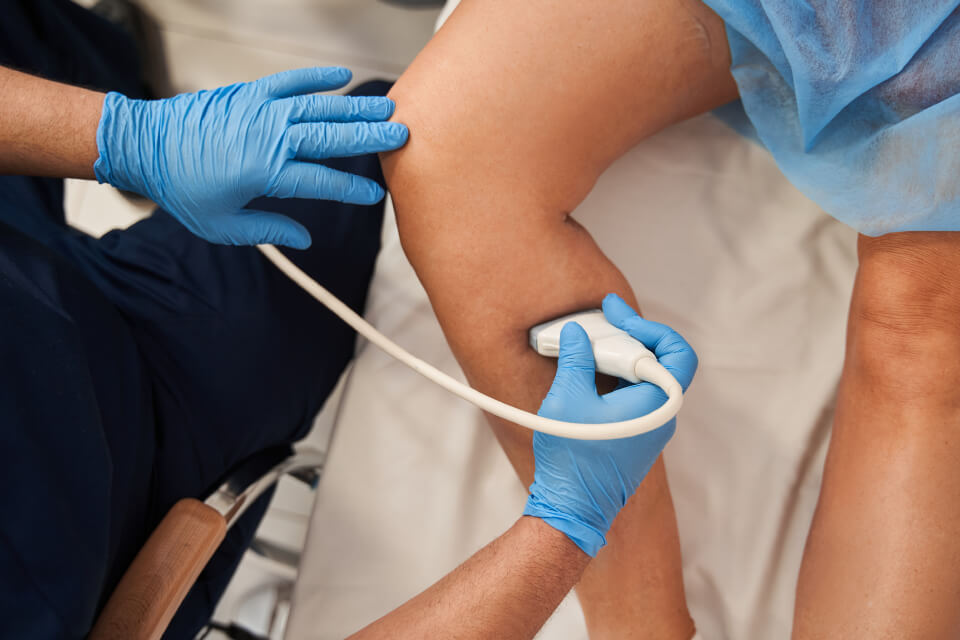What to Know
Many people mistake the symptoms of PAD with normal signs of aging, but if left untreated, serious health complications, such as heart attack, stroke, or amputation, can occur. Do not assume pain is normal or is not important. A simple outpatient procedure can drastically improve circulation and symptoms. Understand symptoms and risk factors and discover how the skilled and compassionate team at Richmond Vascular Center is providing life changing care through the diagnosis and treatment of PAD.
Know the Signs
While some of the 10 million people affected by peripheral arterial disease (PAD) may have no symptoms, others may experience one or more of the following:
- Cramping in calf, thigh, hip, or buttock muscles that begins after activities like walking and resolves quickly with rest
- Pain in toes, feet, or legs while at rest
- Leg numbness or weakness
- Coldness in lower legs or feet
- Sores or ulcers on toes, feet, or legs (often found at pressure points) that take two months or longer to heal. Please note that these require immediate medical attention to prevent wounds from progressing to gangrene.
- Shiny or discolored skin on legs
- Feet or toes that appear blue
Are you at risk?
In addition to knowing the symptoms of peripheral arterial disease (PAD), it is important to learn which risk factors increase the likelihood of developing this disease. Family and social history play a big role in determining if an individual suffers from PAD and there is a significant increase in diagnoses for those who are:
- Current or former cigarette smokers
- Diabetic
- Prone to high cholesterol or high blood pressure
- Obese
- Part of a family with a history of PAD, heart disease, or stroke
- Over 65 years old
- Not regular exercisers
- Experiencing kidney failure
Guiding the path to vascular health.
At Richmond Vascular Center, our expert team can diagnose peripheral arterial disease (PAD) using proven methods to assess vascular health with no hospitals and no long recoveries. A patient's initial visit includes a comprehensive assessment of existing symptoms, lifestyle, and family history. Additionally, our knowledgeable physicians perform a thorough physical examination which includes a diagnostic test called an ankle brachial index (ABI). This painless, non-invasive test gauges blood flow by comparing the blood pressure within the arms to that of the legs.
If the results indicate the presence of PAD, an arteriogram may be recommended. An arteriogram lets our physicians see a complete overview of artery plaque buildup and blood flow.
Proven treatments. Trusted Physicians.
During this outpatient procedure, patients are sedated while a tiny needle is inserted into an artery in the wrist or groin. From there, our physicians will insert a small plastic tube known as a catheter into the arterial system and inject dye into the blood vessels. This allows them to fully investigate potential problem areas and move directly to several modes of treatment when necessary.
Angioplasty
After taking the arteriogram images, if the symptoms and severity of a blockage warrants intervention, an angioplasty can be performed immediately. During this procedure, your doctor uses a specialized balloon device to expand the artery and compress the blockage, allowing blood flow to resume properly.
Atherectomy
If a peripheral artery within the arms or legs requires attention, our physicians may also consider performing an atherectomy prior to angioplasty using a tiny catheter to shave or vaporize the plaque or fatty deposits obstructing blood flow within the vessel.
Stent
When blood flow is still considered insufficient, a tube like scaffold, known as a stent, may be inserted to help keep the treated artery open.
Proven treatments. Trusted Physicians.
During this outpatient procedure, patients are sedated while a tiny needle is inserted into an artery in the wrist or groin. From there, our physicians will insert a small plastic tube known as a catheter into the arterial system and inject dye into the blood vessels. This allows them to fully investigate potential problem areas and move directly to several modes of treatment when necessary.
Angioplasty
After taking the arteriogram images, if the symptoms and severity of a blockage warrants intervention, an angioplasty can be performed immediately. During this procedure, your doctor uses a specialized balloon device to expand the artery and compress the blockage, allowing blood flow to resume properly.
Atherectomy
If a peripheral artery within the arms or legs requires attention, our physicians may also consider performing an atherectomy prior to angioplasty using a tiny catheter to shave or vaporize the plaque or fatty deposits obstructing blood flow within the vessel.
Stent
When blood flow is still considered insufficient, a tube like scaffold, known as a stent, may be inserted to help keep the treated artery open.
Sharing knowledge. Empowering Patients.
What are the benefits of receiving peripheral arterial disease (PAD) treatments at Richmond Vascular Center?
As a trusted partner with an established reputation for excellence, Richmond Vascular Center is dedicated to providing high-quality care in a convenient, outpatient setting. With no overnight hospital stays required, procedures are both cost effective and efficient. Our expert physicians use proven methods to ensure patients return to normal activities with no pain and provide subspecialized support for wound treatment and prevention.
Will my insurance cover both the diagnostic tests and procedures done in the outpatient setting?
Yes. At Richmond Vascular Center, our patient-focused staff is committed to ensuring that all referrals and authorizations are completed prior to your initial visit.
How can I prevent PAD or its progression after treatment?
Many people can manage the symptoms of PAD and stop the progression of this disease through lifestyle changes, such as:
- Quitting smoking
- Taking medications as directed
- Maintaining healthy blood sugar levels, especially for diabetics
- Exercising regularly, ideally 30 minutes of exercise several times a week
- Lowering cholesterol and blood pressure levels
- Eating foods that are low in saturated fats
- Maintaining a healthy weight
- Visiting a primary care doctor regularly
Contact

Friendly and professional staff. Very short wait time. They took their time to figure out what was happening with my legs!




